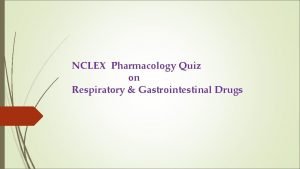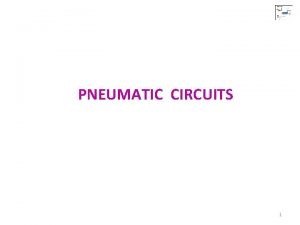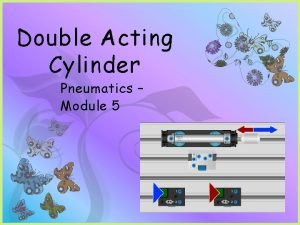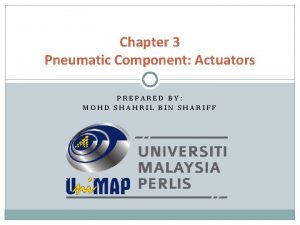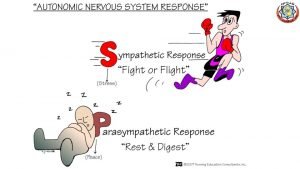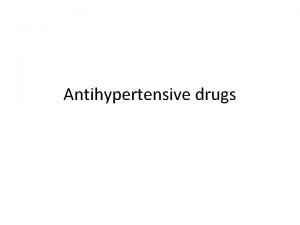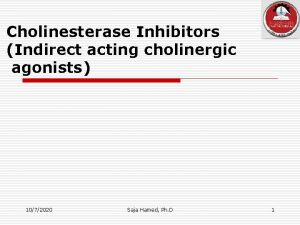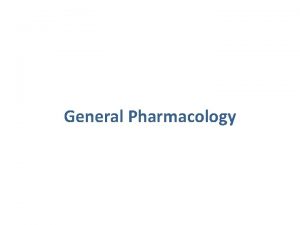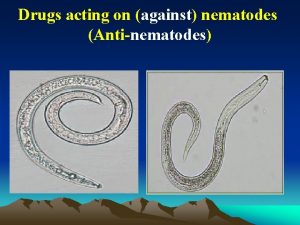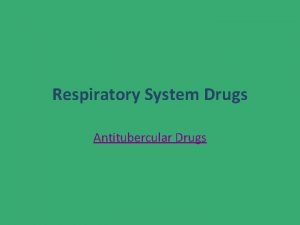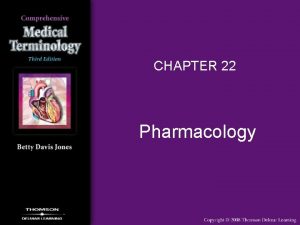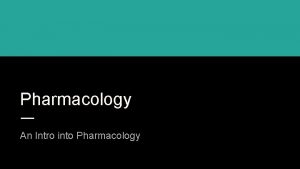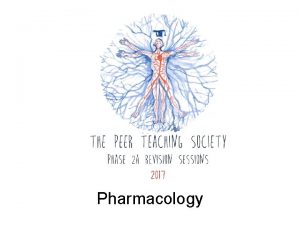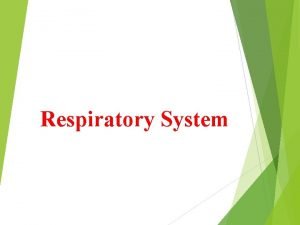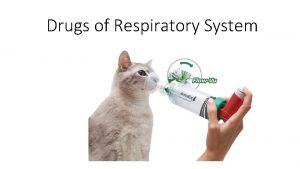DRUGS ACTING ON RESPIRATORY SYSTEM Dept of Pharmacology





![• Guaiacol ([Obtained form wood creosote]; 100 -200 mg), tolu balsum (0. 3 • Guaiacol ([Obtained form wood creosote]; 100 -200 mg), tolu balsum (0. 3](https://slidetodoc.com/presentation_image_h2/6b20e091efb68e07d4e166a6cf41f898/image-6.jpg)


























- Slides: 32

DRUGS ACTING ON RESPIRATORY SYSTEM Dept. of Pharmacology CIPS

Cough suppressants & expectorants • Cough is protective reflex, its purpose being expulsion of respiratory secretions or foreign particles form the lungs and upper airway passages. • Cough may be useful (productive: sputum is coughed up/ drain the airway) or useless (nonproductive/ dry) • Useless cough should be suppressed • Types of cough– Classified based on duration, characters, quality and timing – Acute : Sudden onset/ less than 3 weeks – Sub-acute : 3 -8 weeks – Chronic : longer than eight weeks


• • Drugs for cough Cough can be treated as a symptom (nonspecific therapy) or with specific remedies (antibiotics, etc. ) Nonspecific therapy – Pharyngeal demulcents: Lozenges, cough drops, linctuses containing syrup, glycerine, liquorice. – Expectorants: • Directly acting: Sodium and potassium citrate or acetate, potassium iodide, guaiphenesin (glyceryl guaiacolate), balsum of tolu, vasaka and terpin hydrate. • Mucolytics: Bromhexine, ambroxol, acetyl cysteine, carbocisteine. − Antitussives (Cough center suppressants): − Opioids: Codeine, pholcodeine, ethylmorphine, morphine. − Nonopioids: Noscarpine, dextromethophan, oxeladin, chlorphedianol. − Antihistamines: Chlorpheniramine, diphenhydramine, promethazine.

Demulcents and expectorants: • Pharyngeal demulcents sooth the throat and reduce afferent impulses from the inflamed/irritated pharyngeal mucosa, thus provide symptomatic relief in dry cough arising from throat. • Expectorants (Mucokinetics) are drugs believed to increase bronchial secretion or reduce its viscosity, facilitating its removal by coughing • Sodium citrate or acetate (0. 3 - 1 g): – Increase bronchial secretion by salt action. • Potassium iodide (0. 2 - 0. 3 g): – Act directly on the bronchial secretory cells and are excreted into the respiratory tract. – It is an irritant and increase the volume of secretion. – The irritant action is not desirable if bronchial mucosa is acutely inflamed. – Dangerous in patients sensitive to iodine and interferes with thyroid function test. – Prolonged use can induce goiter and hypothyroidism.
![Guaiacol Obtained form wood creosote 100 200 mg tolu balsum 0 3 • Guaiacol ([Obtained form wood creosote]; 100 -200 mg), tolu balsum (0. 3](https://slidetodoc.com/presentation_image_h2/6b20e091efb68e07d4e166a6cf41f898/image-6.jpg)
• Guaiacol ([Obtained form wood creosote]; 100 -200 mg), tolu balsum (0. 3 -0. 6 g), Vasaka syrup (2 -4 ml) and terpin hydrate (0. 1 -0. 3 g) − Directly increase bronchial secretion and mucosal ciliary action − Gastric upset and rash can occur • Ammonium salts (o. 3 -1 g): – Gastric irritants – Reflexly enhance bronchial secretion and sweating – Nauseating because of unpleasant taste Mucolytics • Bromhexine/ Ambroxol: – Derivative of the alkaloid vasicine obtained from Adhantoda vasica – Potent mucolytic and mucokinetic, capable of inducing thin copious bronchial secretion – depolymerises mucopolvsaccharides directly as well as by liberating lysosomal enzymes – dissolving hard phlegm/ mucus plugs – Side effect: Rhinorrhoea, lacrymation, gastric irritation, hypersensitivity.

• Acetylcysteine: • Derivatives of cysteine • Reduce/ open the disulfide bridges in mucoproteins present in sputum. • These drugs also act as antioxidants and may therefore reduce airway inflammation. • Side effects: Not popular one Antitussives • These are drugs that act in the CNS to raise threshold of cough centre or act peripherally on the respiratory tract to reduce tussal impulses or both these actions. • Because they aim to control rather than eliminate cough, antitussives should be used only for dry unproductive cough or cough is unduly tiring, disturbs sleep or is hazardous (hernia, piles, cardiac disease, ocular surgery).

• • Opioids (Codeine/ pholcodeine): Codeine: – An opium alkaloid; less potent than morphine – Codeine, hydrocodone and hydromorphone are sensitivity of central cough center to peripheral stimuli and mucosal secretions. – Suppresses cough center (for 6 h). – The antitussive action is blocked by naloxone – Abuse liability is low, but present; – constipation is the chief drawnback. – Higher doses respiratory depression and drowsiness can occur- driving may beimpaired. – Dose: adult 10 -30 mg frequently used as syrup codeine phos. 4 -8 ml. • Pholcodeine: – Similar in efficacy as antitussive to codeine. – Long acting codeine (12 h); Dose: 10 -15 g • Ethylmorphine: – Similar to codeine; Dose: 10 -15 mg.

• Nonopioids: • Noscapine (Narcotine): – Opium alkaloid of benzoisoquinoline. – It depresses cough but not narcotic, analgesic or dependence including properties. – Equipotent antitussive as codeine and useful in spasmodic cough. – Side effects: Headache, nausea. – It can produce bronchoconstriction by stimulating histamine release. • Dextromethorphan: − Synthetic compound; d-isomer has selective antitussive action; lisomer has analgesic property. − Effective as codeine, doesn’t depress the mucociliary function of airwaymucosa. − Antitussive effect is not blocked by naloxone − Side effects: Dizziness, nausea, drowsiness, ataxia. − Dose: 10 -20 mg adult

• Antihistamines – H 1 receptor antagonist have little effect on rhinitis associated with colds. – Antihistamines reduce the parasympathetic tone of arterioles and decrease secretion through their anticholinergic activity. – Chlorpheniramine (2 -5 mg), diphenhydramine (15 -20 mg) and promethazine (15 -20 mg) are commonly used as aantitussives. – Second generation antihistamines like terfenadine, loratadine are ineffective. • Bronchodilators – Bronchospasm and can induce or aggravate cough. – Pulmonary receptor stimulation can induce both cough and bronchoconstriction. – Bronchodilators relieve cough and clear secretions by increasing surface velocity of airflow during cough.

DRUGS FOR BRONCHIAL ASTHMA • • • Bronchial asthma is characterized by hyper responsiveness of tracheobronchial smooth muscle to a variety of stimuli, resulting in narrowing of air tubes, often accompanied by increased secretion, mucosal edema and mucus plugging. Symptoms include dyspnoea, wheezing, cough Asthma is recognized to be a primarily inflammatory condition: inflammation underlying hyperreactivity. May be demonstrated as allergic basis or trigger factors (infection, irritants, pollution, exercise, exposure to cold air, psychogenic). Extrinsic asthma: It is mostly episodic, less prone to status asthmaticus. Intrinsic asthma: It tends to be perennial, status asthmaticus is more common. – Mast cells (present in lungs) and inflammatory cells recruited as a result of the initial reaction produce a multitude of mediators: • Release of mediators stored in granules(immediate): histamine, protease enzyme, TNFα

• Release of phospholipids from cell membrane followed by mediator synthesis (within minutes) : PGs, LTs, P AF. • Activation of genes followed by protein synthesis (over hours): Interleukins, TNFα • These mediators together constrict bronchial smooth muscle cause mucosal edema, hyperemia and produce viscid secretions, all resulting in reversible airway obstruction. Chronic obstructive pulmonary diseases (COPD): • Includes chronic bronchitis and emphysema – chronic bronchitis: cough associated with inflammation of the bronchioles – Emphysema: permanent destruction and enlargement of the air spaces distal to the bronchioles • COPDs results airway obstruction, dyspnea, ↓ blood O 2 concentrations and ↑blood CO 2 concentrations.

• Risk factor of COPD: Smocking and old age • Treatment: Bronchodilators and long time oxygen therapy. Antibiotics can be used to treat acute exacerbations caused by bacterial inf. • Approaches to treatment: – Prevention of AG: AB reaction – Neutralization of lg. E (reaginic antibody): malizumab – Suppression of inflammation and bronchial hyperreactivity-corticosteroids – Prevention of release of mediators--mast cell stabilizers – Antagonism of released mediators--leukotriene antagonists, antihistamines, PAF antagonists. – Blockade of constrictor neurotransmitter: anticholinergics – Mimicking dilator neurotransmitter-sympathomimetics. – Directly acting bronchodilators--methylxanthines.

Classification: • Bronchodilators: – β - Sympathomimetics: Salbutamol, Terbutaline, Bambuterol, Salmeterol, Formoterol, Ephedrine. – Methylxanthines: Theophylline (anhydrous), Aminophylline, Choline theophyllinate, Hvdroxyethyl theophylline, Theophylline ethanolate of piperazine, Doxophylline. – Anticholinergics: Ipratropium bromide, Tiotropium bromide. • Leukotriene antagonists: Montelukast, Zafirlukast • Mast cell stabilizers: Sodium cromoglycate, Ketotifen. • Corticosteroids: − Systemic: Hydrocortisone, Prednisolone − Inhalational: Beclomethasone dipropionate, Budesonide, Fluticasone propionate, Flunisolide, Ciclesonide. • Anti-lg. E antibody : Omalizumab


Sympathomimetics: • The selective β 2 agonist is the primary bronchodilators used in the treatment of asthma/ acute asthmatic attacks. • β 2 adrenergic receptor agonists stimulates the beta receptor, increasing the c. AMP concentration in smooth muscle and causing bronchodilatation. • It also increase the conductance of large Ca 2+-sensitive K+ channels in airway smooth muscle, leading to membrane hyperpolarization and relaxation. • The selective β 2 agonist relax the bronchial smooth muscle without affecting cardiac function. In higher doses selective β 2 agonist increasing the heart rate by stimulating the cardiac β 1 -receptor. • The selective β 2 agonist produce hypertension to patient those receiving digitalis. • Types: – Long-acting β 2 adrenergic receptor agonists (Salmeterol; formoterol) – Short-acting β 2 adrenergic receptor agonists(albuterol, levalbuterol, metaproterenol, terbutaline, and pirbuterol )

• Salbutamol: – Selective β 2 agonists with less cardiac side effects – Inhaled salbutamol produce bronchodililation within 5 -min and the action lasts for 2 -4 h. – Used for acute asthmatic attack. Not suitable for prophylaxis – Side effects: Palpitation, restlessness, nervousness, throat irritation and ankle edema. – Metabolism: metabolized in gut; oral bioavailability is 50%. – Duration of action: oral salbutamol acts 4 -6 h. – Dose: 2 -4 mg/ oral; 0. 25 - 0. 5 mg/ i, . p. , or s. c. , ; 100 -200 μg/ inhalation • Terbutaline: – Similar to salbutamol; regular use dose not reduce bronchial hyperreactivity – Dose: 5 mg/ oral; 0. 25 mg/ i, . p. , or s. c. , ; 250 μg/ inhalation

• • • Bambuterol: – Biocarbamate ester of prodrug of terbutaline – Slowly hydrolyzed in plasma and lung by pseudocholinesterase to release the active drug over 24 h. It also reversely inhibits pseudocholinesterase in a dose dependent manner. – Used in chronic bronchial asthma in a singe evening dose of 10 -20 mg/ oral. Salmeterol: – First long acting selective β 2 agonists with slow onset of action – Twice daily for maintain therapy/ nocturnal asthma, but not for acute asthma – Concurrent use of inhaled glucocorticoid with salmeterol is advised for patientwith persistent asthma. – COPD: equivalent to inhaled anticholinergics in COPD. Reduce breathlessness byabolishing the reversible component of airway obstruction. Formoterol: – Long acting selective β 2 agonists which acts 12 h when inhaled. – Compare to salmeterol it has a faster onset of action (with in 10 min)

• Methylxanthines – Theophylline and its derivatives are most commonly used for the treatment of COPD and asthma. – Caffeine, theophylline and theobromine are naturally occurring xanthine alkaloids which have qualitatively similar actions. – MOA: • Methylxanthines inhibits cyclic nucleotide phosphodiesterase (PDEs), thereby • • • preventing conversion of c. AMP and c. GMP to 5’-AMP and 5’-GMP, respectively. Inhibition of PDEs will lead to an accumulation of intracellular c. AMP and c. GMP. Bronchodilataion, cardiac stimulation and vasodilatation occur when c. AMP level rises in the concerned cells. Theophylline and related methylxanthines are relatively nonselective in the PDE subtypes inhibitor. Theophylline is a competitive antagonist at adenosine receptors. Adenosine can cause broncho constriction in asthmatics and potentiate immunologically induced mediator release from human lung mast cells. Methylxanthines inhibits the adenosine action thereby casing bronchodilataion.


• Pharmacological actions: • CNS: – Stimulant; affects higher center. – Caffeine 150 -200 mg produce a sense of wellbeing, alertness, beats boredom, allays fatigue and improve performance and increase the motor activity. Caffeine is more active than theophylline in producing these effects. – Higher dose cause nervousness, restlessness, panic, insomnia and excitements. – Still higher dose cause tremors, delirium and convulsions. Theophylline is moretoxic than caffeine. – Stimulates medullary vagal, respiratory and vasomotor centers. – High dose: Vomiting and gastric irritation and CTZ stimulation.

• • CVS – Stimulates the heart and increase force of contraction. Increase the heart rate(direct action) but decrease it by vagal stimulation- net effect is variable – Tachycardia; increased cardiac output; increased cardiac work – High dose: cardiac arrhythmias – Effect on blood pressure is variable and unpredictable. Usually a rise in systolic and fall in diastolic BP is observed. • Vasomotor center and direct cardiac stimulation- tends to raise BP • Vagal stimulation and direct vasodilatation- tends to lower BP Smooth muscles: – Relaxation – Theophylline is more potent and slow, sustained dose related bronchodilatation – Increase vital capacity - Direct action due to adrenergic stimulation – Biliary spasm is relived, but the effects on intestines and urinary tract is negligible. – Theophylline is more potent; caffeine has minimal actions.

• • • Kidney – Mild diuretics – Inhibiting tubular reabsorption of Na+ and water – Increasing vascular blood flow and g. f. r. – Theophylline is more potent; caffeine has minimal actions. Skeletal muscles: – Caffeine enhance contractile power. In high dose it increases release of Ca+ from sarcoplasmic reticulum by direct action. – Twitch response at low doses. – Caffeine facilitates neuromuscular transmission by increasing Ach release. Stomach: – Enhance secretion of acid and pepsin – Gastric irritation (more with theophylline) Metabolism – Increase BMR. – Plasma free fatty acid levels are increased. Mast cells and inflammatory cells: – Theophylline inhibits the release of histamine and other mediators form mast cells and active inflammatory cells.

• • • Theophylline Pharmacokinetics: – Absorption: Absorbed orally; rectal absorption form suppositories is erratic. – Distribution: All tissues; cross BBM; crosses placenta and is secreted in milk; 50%plasma protein bound – Metabolism: Metabolized in liver (CYP 1 A 2) by demethylation and oxidation. – Excretion: Excreted in urine; 10 % of total administration excreted unchangedform. Elimination rat various considerably with age (age dependent excretion). – Adult t½ is around 7 -12 h. Children elimination is much faster (t½ 3 -5 h); In premature infants has prolonged t½(24 -36 h). Adverse effects: – Narrow margin safety – CVS and CNS stimulant; ADRs not dependent to dose; GIT distress • Children are more liable to developed CNS toxicity • Rapid i. v injection cause- precordial pain, syncope and sudden death

• • Interactions: – Theophylline metabolism decreased by smoking, phenytoin, rifampicin, phenobarbitone and charcoal broiled meatmeal. , which increases the parenthesis. – Erythromycin, ciprofloxacin, cimetidine, oral contraceptives and allopurinolinhibits CYP 1 A 2 and increasing theophylline plasma concentraction; doseshould be reduced to 2/3. – Theophylline reduce the effects of phenytoin, lithium. – Theophylline enhance the effects of furosemide, sympathomimetics, digitalis, oral anticoagulants and hypoglycemics. Indications: – Primarily used to treat chronic obstructive lung disorders and asthma. – Also used to treat apnea

Anticholinergics • Ipratropium/ tiotropium (derivative of atropine) – Parasympathetic activation/ release of ACh cause bronchoconstriction andincrease mucus secretion. – Blocking the action of ACh by anticholinergic drugs produce bronchodilation and also reduce the volume of respiratory secretion. – Less effective than sympathomimetic. – Inhaled ipratropium/ tiotropium are choice of bronchodilator choice in. COPD. – Tritropium produce longer duration of action than ipratropium – ADR: Dry mouth, respiratory tract discomfort

Leukotriene antagonists • Montelukast, Zafirlukast – Both are having similar action and clincial utility – Block the cys-leukotrienes (LTC 4, LTD 4, LTE 4) – Alternative for inhaled glucocorticoids – Prophylactic therapy for mild, moderate asthma; not used for terminating asthma. – Both are very safe drugs and ADRs are few (headache, rashes); eosinophilia and neuropathy are infrequent. Few cases Churg-Strauss syndrome (vasculitis with eosinophilia) have been reported. • Dose: Montelukast 10 mg OD, Zafirlukast 20 mg BD


Corticosteroids – Corticosteroids are not bronchodilator; benefit by reducing bronchial hyperreactivity, mucosal edema and by suppressing inflammatory. • Inhaled glucocorticoids are partially absorbed and because of their systemic AEs • oral glucocorticoids are usually reserved for patients with severe persistent asthma. – Inhaled steroids • High topical and low systemic activity (due to poor absorption/ first pass metabolism). • Inhaled steroids are not recommended for patient with mild or episodic asthma. High dose inhaled steroids are beneficial for advanced COPD with frequent exacerbations. – Systemic steroid therapy • Sever chronic asthma: Not contorted by bronchodilator and inhaled steroids. • Status asthmaticus/ acute asthma exacerbation

• Mast cell stabilizers Sodium cromoglycate, Ketotifen – Inhibits degranulation of mast cell by trigger stimuli and prevent the release of histamine, LTs, PAF, interleukins etc. from mast cells. – Inhibition of mediator release by cromolyn is through blockade of calcium influx in mast cells. – Long time therapy reduce cellular inflammatory response. – It is not histamine antagonist/ bronchodilator- ineffective in asthmatic attack. – Pharmacokinetic: • Not absorbed orally. It is administered as an aerosol through metered dose inhaler delivering 1 mg per dose; 2 puffs 4 times a day • Small fraction of the inhaled drug is absorbed systemically and excreted unchanged form in urine and bile. – Not popular- production of cough and bronchospasm because of particulate nature of the inhalation

• Uses: – Bronchial asthma: Sodium Cromoglycate is used as a long term prophylactic inpatients not adequately controlled by inhaled bronchodilators. Alternative for inhaled steroids in mild to moderate asthma but not severe cases. – Allergic rhinitis: Cromoglycate is not nasal decongestant, regular prophylactic useas a nasal spray produces symptomatic improvement in many patients. – Allergic conjunctivitis: Regular use as eye drops is benificial in some chronic cases – Adverse effects (cromoglycate): Bronchospasmthroat irritation, cough, headache, arthralgia, rashes and dysuria, rarely nasal congestion – Adverse effects (Ketotifen): Generally well tolerated, sedation dry mouth, dizziness, nausea and weight gain

Anti-lg. E antibody • Omalizumab – recombinant DNA-derived monoclonal antibody – Selectively binds to human immunoglobulin E (Ig. E) and decrease bindingaffinity of Ig. E to the high-affinity Ig. E receptor on the surface of mast cellsand basophils, reduce allergic response. – Omalizumab may be particularly useful for treatment of moderate to severeallergic asthma in patients who are poorly controlled with conventionaltherapy. – Due to the high cost of the drug, limitations on dosage, and limited clinicaltrial data, it is not currently used as firstline therapy.
 Pharmacology of drugs acting on respiratory system
Pharmacology of drugs acting on respiratory system Respiratory pharmacology quiz
Respiratory pharmacology quiz Adrenal drugs pharmacology
Adrenal drugs pharmacology Respiratory zone
Respiratory zone Respiratory system circulatory system digestive system
Respiratory system circulatory system digestive system Pilot control single acting cylinder is also known
Pilot control single acting cylinder is also known Fluidsim pneumatics examples
Fluidsim pneumatics examples Rodless cylinder working principle
Rodless cylinder working principle Pantomimish
Pantomimish Direct cholinomimetics
Direct cholinomimetics Centrally acting sympathoplegic drugs
Centrally acting sympathoplegic drugs Indirect acting cholinergic agonists
Indirect acting cholinergic agonists Tiny air sacs at the end of the bronchioles
Tiny air sacs at the end of the bronchioles Circulatory system and respiratory system work together
Circulatory system and respiratory system work together Dept nmr spectroscopy
Dept nmr spectroscopy Fl dept of agriculture
Fl dept of agriculture Organizational structure of finance department
Organizational structure of finance department Inspectors in worcester
Inspectors in worcester Dept. name of organization (of affiliation)
Dept. name of organization (of affiliation) Mn dept of education
Mn dept of education Ms department of finance and administration
Ms department of finance and administration Dept. name of organization (of affiliation)
Dept. name of organization (of affiliation) Employment first ohio
Employment first ohio Poster affiliation
Poster affiliation Vaginal dept
Vaginal dept Gome dept
Gome dept Gome dept
Gome dept Nyttofunktion
Nyttofunktion Gome dept
Gome dept Hoe dept
Hoe dept Lafd interview questions
Lafd interview questions Maine department of agriculture conservation and forestry
Maine department of agriculture conservation and forestry Dept of education
Dept of education

